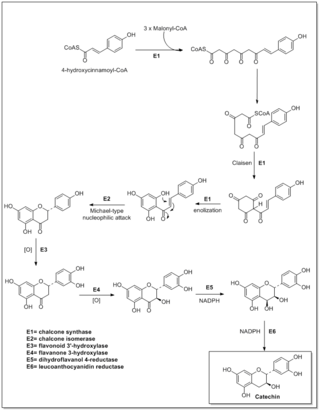Related Research Articles

Daidzein is a naturally occurring compound found exclusively in soybeans and other legumes and structurally belongs to a class of compounds known as isoflavones. Daidzein and other isoflavones are produced in plants through the phenylpropanoid pathway of secondary metabolism and are used as signal carriers, and defense responses to pathogenic attacks. In humans, recent research has shown the viability of using daidzein in medicine for menopausal relief, osteoporosis, blood cholesterol, and lowering the risk of some hormone-related cancers, and heart disease. Despite the known health benefits, the use of both puerarin and daidzein is limited by their poor bioavailability and low water solubility.

Isoflavonoids are a class of flavonoid phenolic compounds, many of which are biologically active. Isoflavonoids and their derivatives are sometimes referred to as phytoestrogens, as many isoflavonoid compounds have biological effects via the estrogen receptor.
In enzymology, a pterocarpin synthase (EC 1.1.1.246) is an enzyme that catalyzes the chemical reaction
In enzymology, an isoflavone 4'-O-methyltransferase is an enzyme that catalyzes the chemical reaction
In enzymology, an isoflavone 7-O-methyltransferase is an enzyme that catalyzes the chemical reaction
In enzymology, a 2'-hydroxyisoflavone reductase (EC 1.3.1.45) is an enzyme that catalyzes the chemical reaction
In enzymology, a biochanin-A reductase (EC 1.3.1.46) is an enzyme that catalyzes the chemical reaction
In enzymology, a 3,9-dihydroxypterocarpan 6a-monooxygenase (EC 1.14.13.28) is an enzyme that catalyzes the chemical reaction
In enzymology, a 4'-methoxyisoflavone 2'-hydroxylase (EC 1.14.14.89, Formerly EC 1.14.13.53) is an enzyme that catalyzes the chemical reaction
In enzymology, an isoflavone 2'-hydroxylase (EC 1.14.14.90, Formerly EC 1.14.13.89) is an enzyme that catalyzes the chemical reaction
In enzymology, an isoflavone 3'-hydroxylase (EC 1.14.14.88, Formerly EC 1.14.13.52) is an enzyme that catalyzes the chemical reaction
In enzymology, a licodione synthase (EC 1.14.13.87) is an enzyme that catalyzes the chemical reaction

Flavonoids are synthesized by the phenylpropanoid metabolic pathway in which the amino acid phenylalanine is used to produce 4-coumaroyl-CoA. This can be combined with malonyl-CoA to yield the true backbone of flavonoids, a group of compounds called chalcones, which contain two phenyl rings. Conjugate ring-closure of chalcones results in the familiar form of flavonoids, the three-ringed structure of a flavone. The metabolic pathway continues through a series of enzymatic modifications to yield flavanones → dihydroflavonols → anthocyanins. Along this pathway, many products can be formed, including the flavonols, flavan-3-ols, proanthocyanidins (tannins) and a host of other various polyphenolics.
The enzyme 2-hydroxyisoflavanone dehydratase (EC 4.2.1.105) catalyzes the chemical reaction
(+)-Menthofuran synthase (EC 1.14.13.104, menthofuran synthase, (+)-pulegone 9-hydroxylase, (+)-MFS, cytochrome P450 menthofuran synthase) is an enzyme with systematic name (+)-pulegone,NADPH:oxygen oxidoreductase (9-hydroxylating). This enzyme catalyses the following chemical reaction
2-hydroxyisoflavanone synthase (EC 1.14.13.136, CYT93C, IFS, isoflavonoid synthase) is an enzyme with systematic name liquiritigenin,NADPH:oxygen oxidoreductase (hydroxylating, aryl migration). This enzyme catalyses the following chemical reactions:
2,7,4'-Trihydroxyisoflavanone 4'-O-methyltransferase is an enzyme with systematic name S-adenosyl-L-methionine:2,7,4'-trihydroxyisoflavanone 4'-O-methyltransferase . This enzyme catalyses the following chemical reaction

Pisatin (3-hydroxy-7-methoxy-4′,5′-methylenedioxy-chromanocoumarane) is the major phytoalexin made by the pea plant Pisum sativum. It was the first phytoalexin to be purified and chemically identified. The molecular formula is C17H14O6.

Chlorophyllide a and Chlorophyllide b are the biosynthetic precursors of chlorophyll a and chlorophyll b respectively. Their propionic acid groups are converted to phytyl esters by the enzyme chlorophyll synthase in the final step of the pathway. Thus the main interest in these chemical compounds has been in the study of chlorophyll biosynthesis in plants, algae and cyanobacteria. Chlorophyllide a is also an intermediate in the biosynthesis of bacteriochlorophylls.